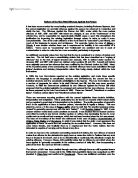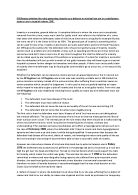Rules of Causation Case. Jess throws paint in Sams eyes. Sam had to go to hospital to have paint removed from his eyes. On the way home, just before his sight was fully recovered, he tripped on the kerb and fractured his skull.
Jess throws paint in Sam's eyes. Sam had to go to hospital to have paint removed from his eyes. On the way home, just before his sight was fully recovered, he tripped on the kerb and fractured his skull. - Outline the rules of causation and briefly discuss whether Jess caused Sam's fractured skull (7 marks) Once it has been established that the defendant performed the act, the prosecution must prove that it was the defendant's conduct which caused those consequences to occur. The prosecution has to show that the defendant's conduct was the factual cause of that consequence, the defendant's conduct was in law the cause of that consequence and there was no intervening act which broke the chain of causation. There are two types of causation, factual causation, the defendant can only be guilty if the consequences would not have happened but for this act. An example of this is, R v Pagett, the defendant used his girlfriend as a human shield against police fire. He shot at the police, they fired back, killing his girlfriend. But for his actions she wouldn't have died. This relates to the scenario because but for Jess throwing paint in Sam's eyes, he would not have been partly sighted and tripped on the kerb resulting in a fractured skull. Causation in law, the defendant's actions must be the operating and substantial cause. An example of this is, R v Smith, two soldiers were
Murder - Notes and Evaluation.
Murder Murder is a common law offence; it has been defined by the decisions of judges in cases and the accepted definition is based on one given by Lord Coke. This is that murder is 'the unlawful killing of a human being under the Queen's peace with malice aforethought, express or implied'. In order for the actus reus to be fulfilled, the following principles must be satisfied : 1.) The defendant must do an act 2.) Which is unlawful 3.) which substantially causes the death of the victim 4.) who was a human being. There used to be a further requirement - that the victim had to die within a year and a day of his last injury by the defendant. This was abolished in 1996. .) The defendant must do an act To be guilty of murder the Defendant must have been proven to have done a voluntary act, although manslaughter can also consist of an omission. This can arise when the Defendant is under a legal duty to act but fails to do so, as in the following situations - Special legal relationship, e.g. Gibbons & Proctor (loco parentis), Statutory Duty, e.g. Road Traffic Act 1972, Voluntary undertaking, Employment duties and Accidental act which creates a dangerious situation. It is very unusual for a charge of murder to be based upon an ommission. 2.) Which is unlawful The act or omission that causes the victims death must be unlawful. It is not unlawful if what is done is in
English law does not normally impose liability for an omission or failure to act despite the fact that there may be compelling moral justifications for doing so. For example, the courts have often explained that there is no legal duty upon a stranger to rescue a drowning child. Consider whether the current legal principles governing omissions are satisfactory (50 marks)
‘English law does not normally impose liability for an omission or failure to act despite the fact that there may be compelling moral justifications for doing so. For example, the courts have often explained that there is no legal duty upon a stranger to rescue a drowning child.’ Consider whether the current legal principles governing omissions are satisfactory (50 marks) The term Actus Reus is the Latin translation of ‘Guilty Act’. The Actus Reus of an offence concerns all those elements of the offence not relating to the defendants state of mind, the Mens Rea. For the Actus Reus the act or omission must be a positive voluntary act on the part of the defendant. If the defendant has no control over his actions then he has not committed the offence. The Actus Reus must also be Positive except in certain cases; this is the area of law that states for someone to commit an offence they must positively cause an act and not an omission to act, The law also states that there is no legal duty upon a stranger to rescue a drowning child. On the other hand, as there are several areas of law, 5 implemented by courts and 1 implemented through parliament, where a duty to act is existent there is often uncertainty on behalf of the defendant that they were under a duty to act in the first place. This could be solved by putting in a ‘good Samaritan’ law such as is in place in
Is the current law on the non-fatal offences against the person satisfactory?
Reform of the Non-Fatal Offences Against the Person It has been recommended by many leading academic lawyers, including Professor Spencer, that the current legislation on non-fatal offences against the person be reformed to modernise and clarify the law. The Offences Against the Person Act 1861, under which the more serious offences of ABH, GBH and GBH with intent are charged, is one of the "workhorses" of the criminal law, and is responsible for approximately 80,000 cases a year; this strengthens the justification for improving the existing legislation through reform in order to make it more comprehensible. One of the main criticisms of the Act is that it is "outmoded" (Jack Straw), and much of the language is arcane and ambiguous. For example, before the case of Wilson v Pringle, it was unclear whether there was a requirement for hostility in the commission of a battery. Terms such as "occasioning" and "maliciously" are outdated and are in need of modernisation in order to make the law more accessible, particularly to laypeople. An additional complexity arises from the fact that the law is contained in a mixture of statute and case law. The Act itself was a consolidating statute that has been described as a "ragbag of offences" due to the lack of logical structure (for example, ABH is defined under section 47, whereas GBH and GBH with intent are defined under sections
OCR Feb 10 Exam Paper Non-Fatal Offences Problem Case. The scenario states that Colin ran towards Sarah waving a knife. The actions by Colin caused Sarah to scream.
OCR Feb 10 Exam Paper - Non-Fatal Offences Sarah is walking home when Colin runs towards her waving a knife. Sarah Screams. Colin grabs Sarah's coat and then punches her in the face which breaks her nose and causes her to fall to the ground. Gregory, a passer-by, runs to help Sarah. Colin lunges wildly at Gregory with the knife and slashes Gregory's hand, causing severe bleeding. Colin takes aim and kicks Sarah in the stomach, causing serious internal injuries. [35] The scenario states that Colin ran towards Sarah "waving a knife". The actions by Colin caused Sarah to scream. The Actus Reus for assault is 'any act which causes the 'victim' (V) to fear immediate unlawful force'. The meaning of immediate was defined in the Smith (1983), a case where a man looked into the window of a women in her flat thus causing her to be terrified, as to meaning "imminent". The fact that Sarah screamed after seeing Colin running towards her illustrates she feared of action imminently. The Mens Rea for Assault is 'intention or recklessness to cause another to fear immediate unlawful force'. By referring to the definition set out in Smith, Richard waving the knife around, coupled with him heading towards Sarah, clearly shows that he was reckless as to make Sarah fear imminent unlawful force. Colin is therefore guilty of committing the Common Law offence of assault, and can be sentenced up to

















